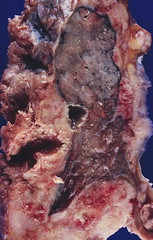 A treatment designed to inhibit a cell protein called CTLA-4 may improve the effectiveness ofchemotherapy for mesothelioma.
A treatment designed to inhibit a cell protein called CTLA-4 may improve the effectiveness ofchemotherapy for mesothelioma.Chemotherapy is considered a front-line treatment for mesothelioma, although it is only moderately effective. Because mesothelioma is a highly aggressive cancer of the mesothelium, chemotherapy is often used as part of a multimodality therapeutic approach. Increasingly, immunotherapy, which involves manipulation of the genes and immune system, is also part of the treatment approach.
CTLA-4 is the name for both a protein and the gene that is responsible for producing it. A recent published study tested the theory that knocking down cellular production of the CTLA-4 protein could slow tumor growth and stimulate the immune system between rounds of chemotherapy.
To test the theory, mice that had been given mesothelioma were injected with a CTLA-4 blocking antibody after each cycle of cisplatin-based chemotherapy. The effectiveness of the treatment was evaluated by measuring the delay in the tumor’s growth and the overall survival of the mice. The research team also tested the ability of the treatment approach to kill mesothelioma cells in the lab.
The results were promising. Compared to the control group that received only chemotherapy, the group that received the anti-CTLA-4 monoclonal antibody did exhibit slowed growth of early-stage mesothelioma tumors. In addition, CTLA-4 therapy increased the immune system’s ability to fight the tumor by increasing the number of killer T-cells.
In summarizing their results, the team concluded, “Blockage of CTLA-4 signaling demonstrated effective anti-cancer effect correlating with inhibiting cancer cell repopulation between cycles of chemotherapy and upregulating tumor infiltrating T-lymphocytes, cytokines and cytolytic enzymes in a murine mesothelioma model.”
It is hoped that these results will lead to a more effective treatment for mesothelioma.















